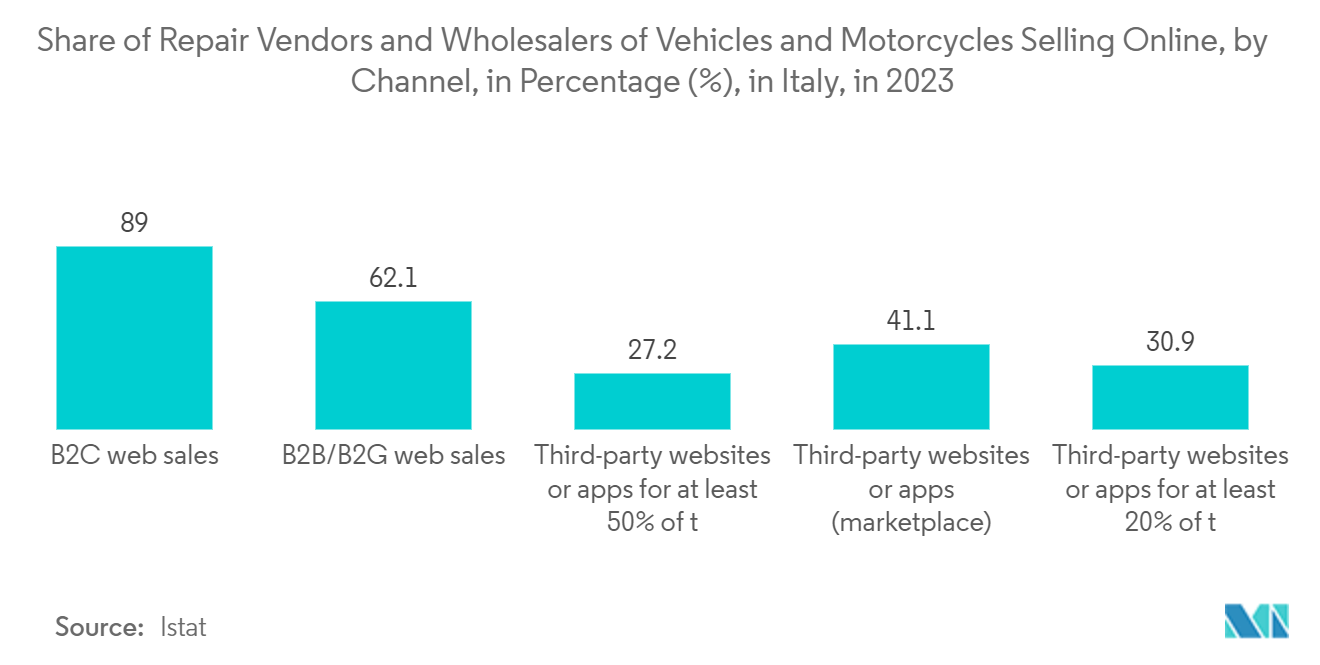Market Trends of Italy Location-Based Services Industry
Outdoor Segment is Expected to Hold Significant Share
- Outdoor positioning capabilities require regional or global coverage. Thus, global navigation satellite systems (GNSS), such as GPS, have been adopted in various applications, such as machine control, multi-modal transport navigation and guidance, synchronization of telecommunications networks, and asset management systems.
- Location-based marketing or geofencing is the most dominant use case in outdoor location-based services (LBS), where personalized content is sent to the user depending on their proximity to a particular location. This helps offline retailers have the same capability as their online counterparts in providing recommendations to users.
- Apps can use geofencing to actively guide their users to their exact location and deliver products and services more effectively by optimizing process delivery (Like ride-hailing services or food delivery platforms). Public transport apps can use geofencing to send general information alerts to consumers, informing them about active changes in the transit system, downtimes, and special announcements near a public transport hub. Apps, such as Google Maps and Waze, inform users of the best routes from their current location, toll payment for road users, and unordinary situations, like heavier-than-usual traffic jams and roadblocks.
- GNSS is the primary technology utilized by outdoor LBS for navigation purposes. According to the Global Positioning System, there are 30 operational satellites in the GPS constellation, which is expected to increase in the coming years. This would improve the error margin and consequently result in better positioning accuracies. However, GNSS doesn't perform well in cluttered buildings, close to walls, indoors, and underground environments, which is one of the market challenges. The studied segment can be noted as moving towards hybrid positioning, which integrates outdoor and indoor location-based services. The hybrid positioning technology is expected to gain significant traction as it enables users to have a seamless indoor and outdoor navigation experience.
- Location-based social networking is basically a convergence between a location-based service and online social networking. Applications, such as Google Maps, allow people to share information regarding their locations, thus making locative social media possible. Based on GPS, location-based social networking primarily uses smartphones that allow users to let large circles of people know where they currently are. Currently, location-based services have become a part of the rapidly growing sectors of the digital world. They are changing the ways in which people explore their lives.
- LBS helps integrate users with vehicle routes, stops, and driver schedules. An alert is triggered if the vehicle stops at an unregistered location or uses an unknown route. According to OICA (Organisation Internationale des Constructeurs d'Automobiles (French)The International Organization of Motor Vehicle Manufacturers), in 2022, Italy's auto industry sold nearly 1.51 million motor vehicles, 87.45 percent of which were passenger cars. Total new vehicle registrations in the country had dropped by 9.8 percent year-over-year due to decreased sales across categories. However, Italy remained the fourth largest vehicle market in Europe in 2022.

Healthcare is Expected to Hold Significant Share of the Market
- Wayfinding, asset tracking, and patient tracking are some of the most popular location-based services, allowing healthcare facilities to satisfy the requirements of patients and their homes while improving the quality of care and operating efficiency. Health service and information providers can react immediately to the varied location of a mobile user by conveying personalized, timely information and services for the user's new roaming region.
- With the help of indoor mapping and navigation products, patients can be assisted in making their way to and through any healthcare facility. Real-time information can be conveyed to the patients depending on where they are in the hospital, allowing them to make appointments on time and find the correct testing area. Patient tracking is essential for more vulnerable patients, such as people with Alzheimer's or younger children. Patients can be discovered immediately in an emergency to deliver care faster and more efficiently.
- An online healthcare facility locator service can help users discover the nearest hospital or clinic based on their location and healthiness needs and even supply them with operating directions and real-time traffic information. Location-based technologies, such as LogicJunction, play a key role in mHealth initiatives since they provide rich data, improve patient engagement, create opportunities for greater personalization of the healthcare experience, and seamlessly connect people, places, and things. MediNav Navigator v. 2.0 is one of the most popular indoor navigation solutions available for hospitals, with features like accurate turn-by-turn indoor navigation, parking planner, and network-wide wayfinding.
- The growing popularity of cloud-based Big Data analytics is one of the trends gaining traction in the market studied. Big Data analytics provide enriching insights into consumer buying patterns so that retailers can grow their sales volume and enhance customer search experiences. Location-as-a-service companies, such as GeoSpice, use big data analytics for offering cloud-based web services and mobile LBS, which can integrate real-time location information and data analytics.
- According to Agenzia Italiana del Farmaco, data from January to December 2023 reveals that Italy spent around EUR 649 Million (USD 716.91 Million) on innovative drugs in hospitals.
- The latter include physician, nursing, and other health services to inpatients, as well as the specialized accommodation services required by inpatients, which may also provide daycare, outpatient, and home healthcare services. Such huge healthcare expenditure would create an opportunity for the studied market.


